Black-tailed Trogon was on my want list last year; I was surprised we didn't see one, though in Eastern Panama they were quite common.
These birds are quite similar to the more widespread Slaty-tailed Trogon. Black-tailed has a heavier (yellow instead of reddish) bill, a red eyering, and a narrow band of white separating the green breast from the red belly.
Lathe spotted another of the Eastern Panama specialties, Barred Puffbird.
Domi said they're known to lump small birds in with large insects and eat one just as happily as another.
Another Chestnut-headed Oropendola. They were common in the camp, but tended to be atop trees.
A look at a pair of Cinnamon Woodpeckers.
While looking at a surprising variety of small flycatchers clustered in one small area (more next post) Domi called out Great Green Macaws screeching. The ground was open enough that we were able to see a half dozen fly steadily past.
We headed back to camp and our driver stopped for a Great Potoo. The bird was hawk-sized.
I assume that these bizarre birds also eat bats like their smaller cousins.





















































